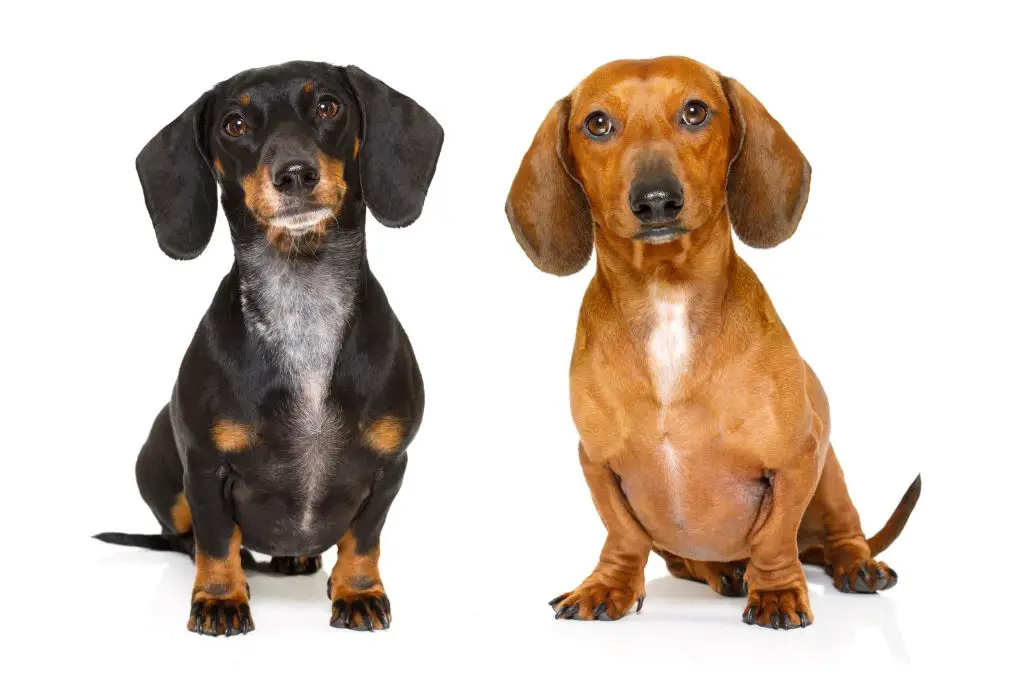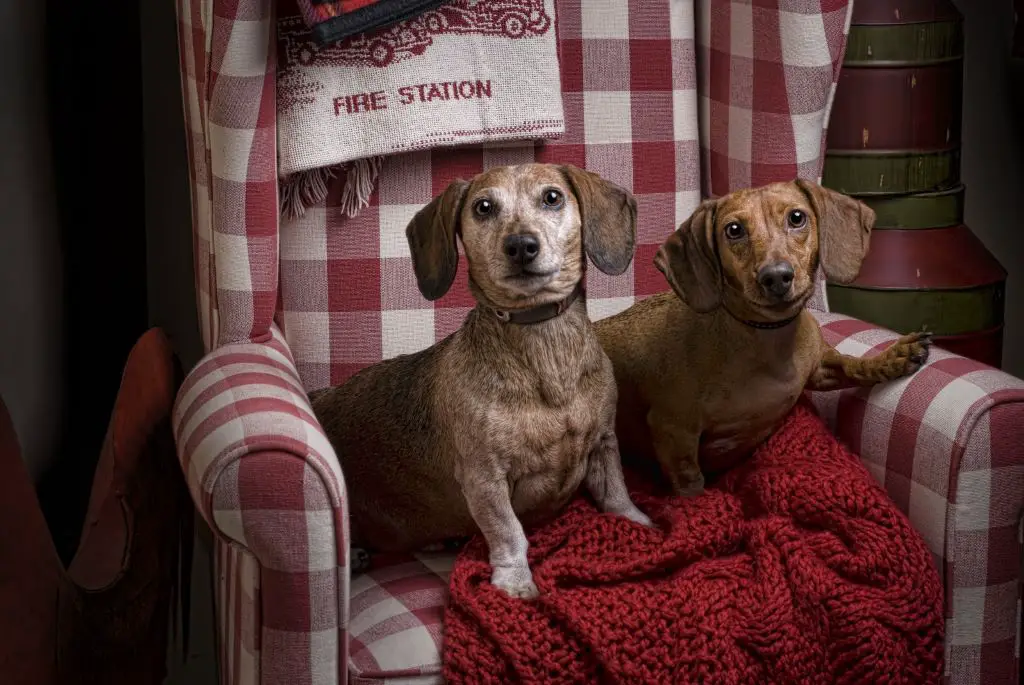Dachshunds, both dapper and darling, are dogs of distinction. But did you know that there’s more to these canine companions than meets the eye? In this article, we’ll delve deep into the differences between standard and miniature dachshunds. From size and weight comparisons to coat and color variations, we’ll provide a comprehensive overview for your understanding.
Can you breed a standard with a miniature? What are the potential health concerns? How do their temperaments differ or align? We’ll cover these questions too!
Whether you’re an aspiring breeder or just an admirer of these adorable dogs, this guide will help you grasp all things Dachshund related. Get ready; it’s time to discover the delightful details about these dogs’ diversity!
Key Takeaways
- Both standard and miniature dachshunds can be bred together due to their similar genetic makeup.
- However, careful consideration is needed due to potential health risks associated with size disparities during breeding.
- Nearly half of all puppies born from a mixed-size pairing may face serious health complications.
- Mixed-size pairings increase the risk of inheriting genetic disorders in the offspring.
Understanding Dachshund Varieties
You might find it fascinating that there are two main varieties of Dachshunds: the standard and the miniature.
The standard dachshund typically weighs between 16 to 32 pounds, while the miniature dachshund does not exceed 11 pounds. It’s this noticeable size difference that sets these two apart.
In understanding Dachshund varieties, you’ll learn that despite their size differences, both types share similar characteristics, such as a long body and short legs – traits that were originally bred for hunting burrowing animals like badgers. Standard dachshunds were utilized for larger prey, whereas miniature ones had tasks involving smaller creatures.
The question ‘can you breed a standard dachshund with a miniature dachshund’ may cross your mind at some point. Technically speaking, yes, it’s possible to breed a mini dachshund with its larger counterpart. This is due to them being of the same species and sharing similar genetic makeup. However, it’s worth noting that careful consideration needs to be given due to potential health risks associated with size disparities during breeding.
So now you know about these different yet closely related dog breeds! It’s always interesting finding out more about our four-legged friends’ unique characteristics and history.
Origins and Purpose
Delving into their origins, it’s captivating to discover that both the larger and smaller versions of these adorable dogs have a shared lineage, bred with purpose and ingenuity. The dachshund breed was initially developed in Germany as hunting dogs, specifically for badgers, due to their long bodies and short legs that allowed them to burrow into dens.
There is no standard dachshund vs miniature battle here; instead, both types were crafted intentionally based on the tasks they were expected to perform.
Interestingly, there are some key considerations when understanding why people choose to breed dachshunds:
- Size: Miniature dachshunds are typically less than 11 pounds, while standard ones can weigh up to 32 pounds.
- Purpose: Standard dachshunds were often used for bigger game like boars, while miniatures targeted smaller prey such as rabbits.
- Temperament: Despite size variations, both miniature and standard dachshunds share similar temperaments – energetic, brave, and sometimes stubborn.
- Health: Breeding between a standard or mini dachshund should be done responsibly, considering possible health implications.
It’s clear that selective breeding plays a crucial role in creating different varieties within the same dog breed, like our lovable long-bodied friends. So whether you’re smitten by a standard or mini Dachshund, remember it all comes down to individual preference combined with responsible breeding practices.
Size and Weight Comparisons
It’s like comparing apples to oranges when it comes to the size and weight of these adorable pooches. A standard-size dachshund is significantly larger than its miniature counterpart, both in terms of length and weight.
Here’s a quick comparison for you:
As you can see, standard dachshunds are about twice as long and can weigh up to three times more than miniature ones. That’s quite the difference! It’s important to note that while miniatures may be small, they’re not just smaller versions of their larger counterparts. Their proportions differ too: miniature or standard; each type has its own distinctive shape.
While this might seem like a minor detail, it could have significant implications if you’re considering breeding your dachshunds. Crossbreeding between these two sizes could result in offspring with unpredictable sizes. Therefore, it’s crucial to understand the differences between the standard and miniature types before making any decisions regarding breeding.
Coat and Color Differences
Don’t be fooled by their size, because when it comes to their coat and colors, these adorable pooches have a world of variety to offer!
When it comes to breeding a dachshund with a standard or miniature one, the coat and color differences can be quite diverse.
Standard dachshunds typically come in three varieties of coats: short-haired (or smooth), long-haired, and wire-haired. Miniature dachshunds also share these same coat types. The short-haired ones have shiny, smooth fur that’s easy to care for, while the long-haired ones boast silky fur that requires regular grooming to prevent matting. Wirehaired dachshunds sport wiry hair with bushy eyebrows and beard giving them a distinctive look.
As for colors, both standard and miniature versions showcase an impressive array of shades, including black and tan, red, cream, chocolate brown, among others. However, the most common color is black and tan, which gives them their iconic look.
So whether you’re considering breeding your beloved dachshund with a standard or a miniature mate or simply adopting one of these lovable pups into your family, remember that these are more than just small dogs with big personalities – they come packed with an extensive palette of beautiful coats and striking colors too!

Unlock Better Skin & Joint Health For Your Dachshund
Breeding Considerations
When thinking about breeding considerations, it’s crucial to note that according to the American Kennel Club, nearly half of all puppies born from a mixed-size pairing may face serious health complications. As a breeder, you must consider these risks before deciding to breed a standard dachshund and a mini.
| Breeding Consideration | Description |
|---|---|
| Size Disparity | A large size difference between parents, specifically in dogs, can lead to birthing complications. For instance, a larger male and smaller female can result in oversized puppies that the mother struggles to deliver. |
| Genetic Disorders | Breeding between dogs of significantly different sizes may increase the risk of the offspring inheriting genetic disorders, as certain genes associated with size may also carry potential for diseases. |
| Unpredictable Traits | When breeding different-sized dogs like standard and miniature dachshunds, the resulting offspring’s traits can be unpredictable. This includes not only physical traits such as size, but also behavioral characteristics. |
| Health Risks | Breeding dogs of significantly different sizes could lead to offspring with a higher potential for health problems, such as joint issues and heart disease. This is due to the physical stress that disproportionate sizes can put on the body of the offspring. |
Remember, just because it is technically possible to breed these two sizes doesn’t mean it should be done without proper thought and preparation. These are living creatures whose health and well-being depend on your decisions as a breeder.
The breeding considerations mentioned above are significant factors when contemplating such a mix. It’s not just about producing cute puppies; there are real implications involved in this process. Hence, responsible breeding should always prioritize the health of both parent dogs and their prospective pups over any other factor.
Possible Health Concerns
While understanding the breeding considerations is an essential step, it’s equally important to be aware of potential health concerns when planning to breed a standard dachshund with a miniature dachshund. The dachshund’s health should be your top priority.
One thing to note about this breed is that both standard and miniature versions are predisposed to certain genetic conditions. Here are some common ones:
Back problems: Dachshunds have long bodies and short legs, which can lead to intervertebral disc disease (IVDD). This condition can cause pain or even paralysis. To help prevent this, maintain an appropriate weight for your dachshunds and avoid activities that strain their backs.
Eye issues: Both types of dachshunds may suffer from progressive retinal atrophy (PRA), leading to blindness. Regular vet check-ups can catch this early on.
Obesity: Being overweight exacerbates many health problems in these dogs. Ensuring a balanced diet and regular exercise will support overall health.
Knowing how long standard dachshunds live is crucial too. They typically live between 12-16 years if well cared for, with good genetics playing a part as well. By understanding the breed standards and potential health risks, you’ll be better equipped to ensure your furry friends’ well-being.
Training and Temperament
It’s not all about the physical aspects; their mental agility and temperament are equally important areas to focus on. Both mini dachshunds and standard dachshunds can be a handful when it comes to training. Their stubbornness, paired with their intelligence, often leads them to think they’re in charge.
Here’s a more detailed version of your chart:
Here’s a more detailed version of your chart:
| Traits | Mini Dachshund Description | Standard Dachshund Description |
|---|---|---|
| Stubborn | Mini Dachshunds can be particularly stubborn, often wanting to do things their way. This can make them slightly challenging to train, especially for first-time dog owners. | Standard Dachshunds are also known for their stubbornness. Their independent nature may require more patience and positive reinforcement during training sessions. |
| Intelligent | Mini Dachshunds are quite intelligent and enjoy problem-solving activities. Their smartness can make them both entertaining and a bit mischievous. | Like their mini counterparts, Standard Dachshunds are also intelligent dogs. They thrive on mental stimulation and can learn new commands and tricks quickly when motivated. |
| Playful | Mini Dachshunds have a playful nature, which can make them great companions for individuals or families. They tend to have bursts of energy and enjoy interactive toys and games. | Standard Dachshunds are playful and energetic, loving games of fetch and other interactive activities. They can be quite exuberant and require regular playtime to burn off their energy. |
| Loyal | Mini Dachshunds are known for their loyalty. They form strong bonds with their owners and can be protective of their family. | Standard Dachshunds are equally loyal, often forming deep attachments to their human family. Their protective nature can make them excellent watchdogs. |
The table illustrates that both breeds share specific traits which can make training more challenging yet rewarding. They’re loyal dogs, and once they’ve bonded with you, they’ll do anything for you. But remember: consistency is key when it comes to training these breeds.
Their temperament ranges from playful and energetic to calm and relaxed, depending on the individual dog’s personality. It’s essential to understand this before deciding to breed a mini dachshund with a standard one, as the puppy may inherit different traits from each parent. Just know that no matter what blend of characteristics your mixed-breed pup ends up with, they’ll be an adorable addition full of personality!
Living with Different Sizes
Ever considered how life might be different with a larger or smaller pup in your home? Dachshunds, whether they’re standard or minis, can bring unique experiences based on their size.
If you’re thinking about either the standard or mini variety, here are some factors to consider.
1. Space: Standard dachshunds may require more space to move around comfortably compared to minis who can easily navigate smaller apartments.
2. Exercise: The energy level and exercise needs of the dog may vary in size. Standards generally need more physical activity than miniature ones.
3. Health Concerns: Both sizes have a predisposition to certain health issues, but larger dogs often come with greater potential health concerns.
4. Training: Training standards can sometimes be easier as they’re less likely to develop small dog syndrome, which is common in many miniature breeds.
Remember that living with different sizes of dachshunds will offer varied experiences and challenges. Whether you choose a standard or a mini, it’s important to understand what suits your lifestyle best and ensure you can provide for your pet’s specific needs without compromising their quality of life.
Frequently Asked Questions
What is the average lifespan of a mixed breed of standard and miniature dachshunds?
The lifespan of a mixed breed between standard and miniature dachshunds isn’t exactly predictable. But generally, dachshunds live between 12 to 16 years. Proper care can potentially extend your pet’s life.
Are there specific diet considerations for a standard-miniature dachshund mix?
Ever considered the importance of diet for your standard miniature dachshund mix? They require a balanced, nutrient-rich diet. Too much weight can strain their long spine, so portion control is paramount. Always consult with a vet.
Do standard and miniature dachshund mixes have unique grooming needs?
Yes, standard and miniature dachshund mixes do have unique grooming needs. Their short coat requires regular brushing to remove loose hairs. Also, their long ears need cleaning to prevent infections. Regular dental care is also essential.
What are the potential behavioral traits of a standard and miniature dachshund mix?
Most dachshunds, regardless of size, are known for their stubbornness. Your standard and miniature mix might be more independent-minded, but also affectionate and playful. They’re lively dogs with a keen sense of humor.
How often should a standard-miniature dachshund mix exercise?
Your standard miniature dachshund mix should exercise daily. Aim for at least 30 minutes to an hour of activity each day, such as walks or play sessions, to keep them healthy and prevent obesity.
Conclusion
So, you’re pondering breeding a standard and a mini Dachshund. It’s possible, but heed my words from the days of yore: consider possible health issues and temperament.
Both sizes are charming, yet they come with unique challenges. Live with both sizes first before making your decision.
Remember, it’s not just about the puppies’ looks; it’s about their health and happiness too.









